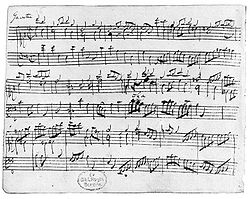Notebook for Anna Magdalena Bach
From Wikipedia, the free encyclopedia
The title Notebook for Anna Magdalena Bach refers to either of two manuscriptnotebooks that the German Baroque composer Johann Sebastian Bach presented to his second wife, Anna Magdalena. Keyboard music (minuets, rondeaux, polonaises,chorales, sonatas, preludes, musettes, marches, gavottes) makes up most of both notebooks, and a few pieces for voice (songs, and arias) are included.
The two notebooks are known by their title page dates of 1722 and 1725. The title "Anna Magdalena notebook" is commonly used to refer to the latter. The primary difference between the two collections is that the 1722 notebook contains works only by Johann Sebastian Bach (including most of the French Suites), while the 1725 notebook is a compilation of music by both Bach and other composers of the era. It provides a nearly unparalleled glimpse into the domestic music of the 18th century and the musical tastes of the Bach family.
Contents[hide] |
[edit]The 1722 notebook: French Suites and miscellany
This notebook contains 25 unbound sheets (including two blank pages), which is estimated to be approximately a third of the original size. It is not known what happened to the other pages. The back and the corners are decorated with brown leather; greenish paper is used for the cover. The title page is inscribed Clavier-Büchlein vor Anna Magdalena Bachin ANNO 1722 in Anna Magdalena's hand. For a reason so far unknown to researchers, Johann Sebastian wrote the titles of three books by theologian August Pfeiffer (died 1698) in the lower right corner of the title page:
- Ante Calvinismus is a shortened and misspelled title of Anti-Calvinismus, oder Unterredungen von der Reformierten Religion (Anti-Calvinism, or Conversations about the reformed religion).
- "Christen Schule item" refers to Pfeiffer's {{Lang|de|Evangelische Christen Schule("Evangelical Christian School").
- AntiMelancholicus refers to Anti-melancholicus, oder Melancholey-Vertreiber (Anti-melancholy, or [something or someone] to drive out the melancholy]).
The notebook contains the following works, most in Johann Sebastian's hand:
- Five keyboard suites. The first three are fragments of the pieces that are now known as the first three French Suites, BWV 812–814. The next two are complete suites, French Suites Nos. 4 and 5, BWV 815–816. The minuets of suites 2 and 3 are separated from the rest of their respective suites and were most probably added at a later date by Anna Magdalena Bach (they are almost certainly in her hand), some time before 1725.
- Fantasia pro organo, unfinished, BWV 573. A short organ piece, 12 complete bars and the beginning notes of the 13th bar.
- Air with variations in C minor, unfinished, BWV 991. The first 10 bars feature coherent two-part writing, but the remaining 35 bars only have one voice written out.
- "Jesus, meine Zuversicht", chorale prelude, BWV 728. A brief (9 bars) piece in three voices, features two sections with repeats for each.
- Minuet in G major, BWV 841 (not to be confused with Petzold's Minuet in G Major in the 1725 notebook). A short dance with simplistic two-part writing and two sections with repeats for each.
[edit]The 1725 notebook
The 1725 notebook is bigger than the 1722 one, and more richly decorated. Light green paper is used for the front cover, Anna Magdalena's initials and the year number "1725" are printed in gold. All pages feature gilt edging. Most of the entries in the 1725 notebook were made by Anna Magdalena herself, with others written in the hand of Johann Sebastian, some by sons Johann Christian and Carl Philipp Emanuel, and a few by family friends such as Johann Gottfried Bernhard and Johann Gottfried Heinrich. Although the 1725 notebook does contain work composed by Johann Sebastian Bach, it also includes works by many other composers. The authorship of several pieces is identified in the notebook itself, while that of others was established by researchers






No comments:
Post a Comment